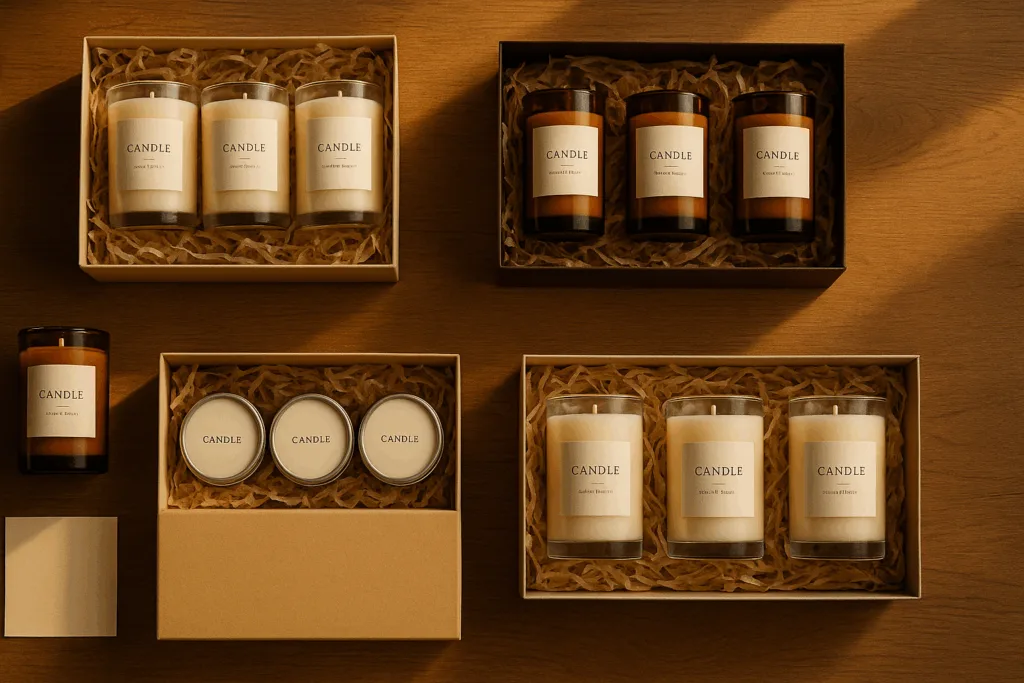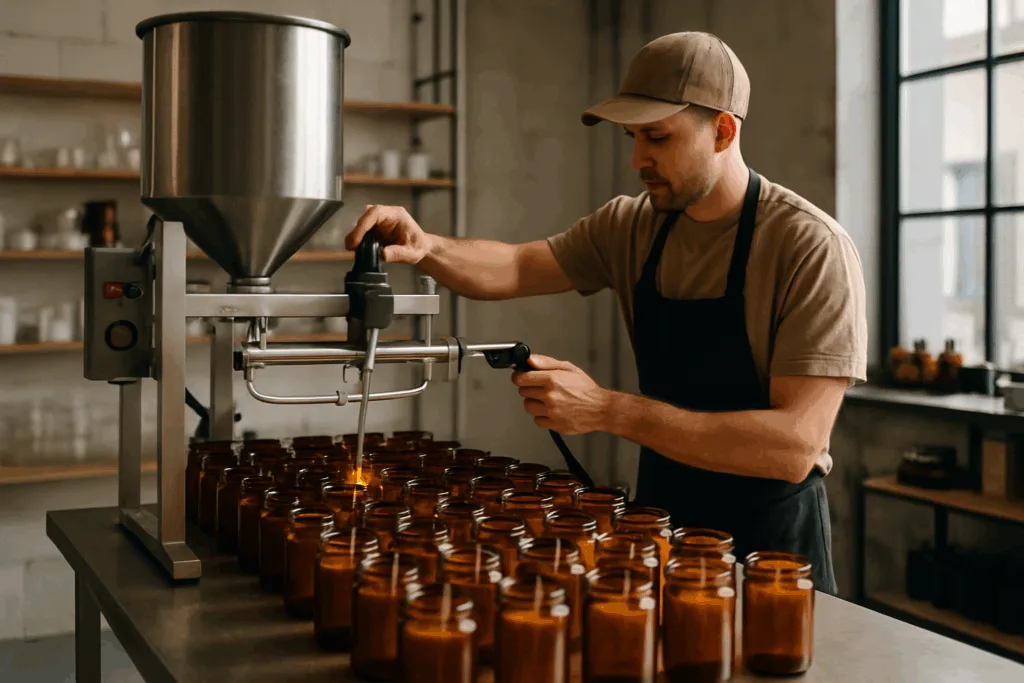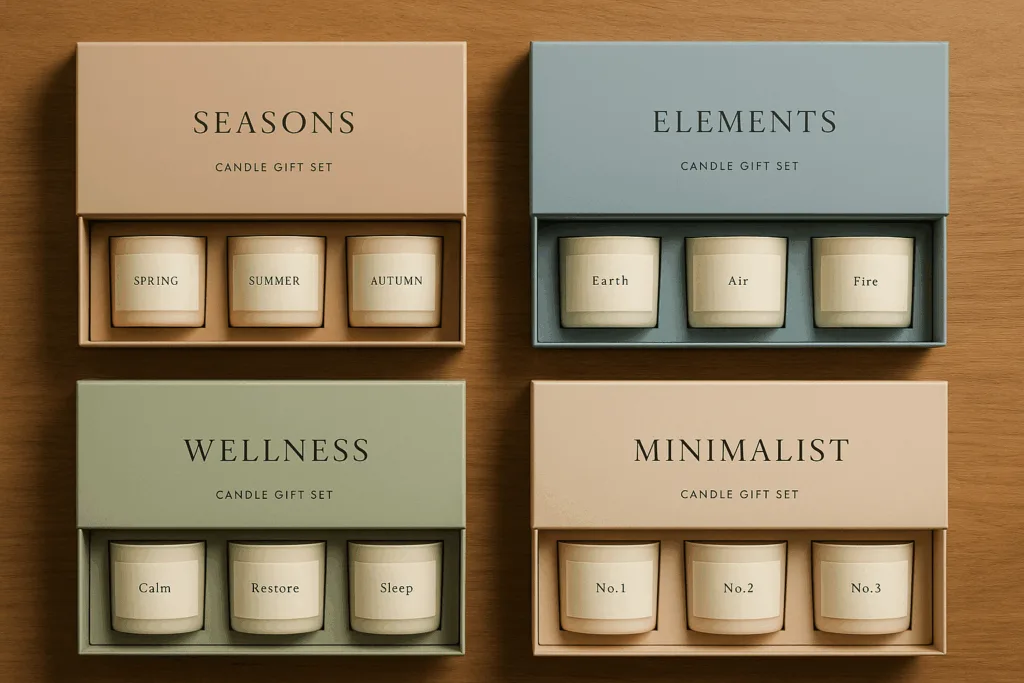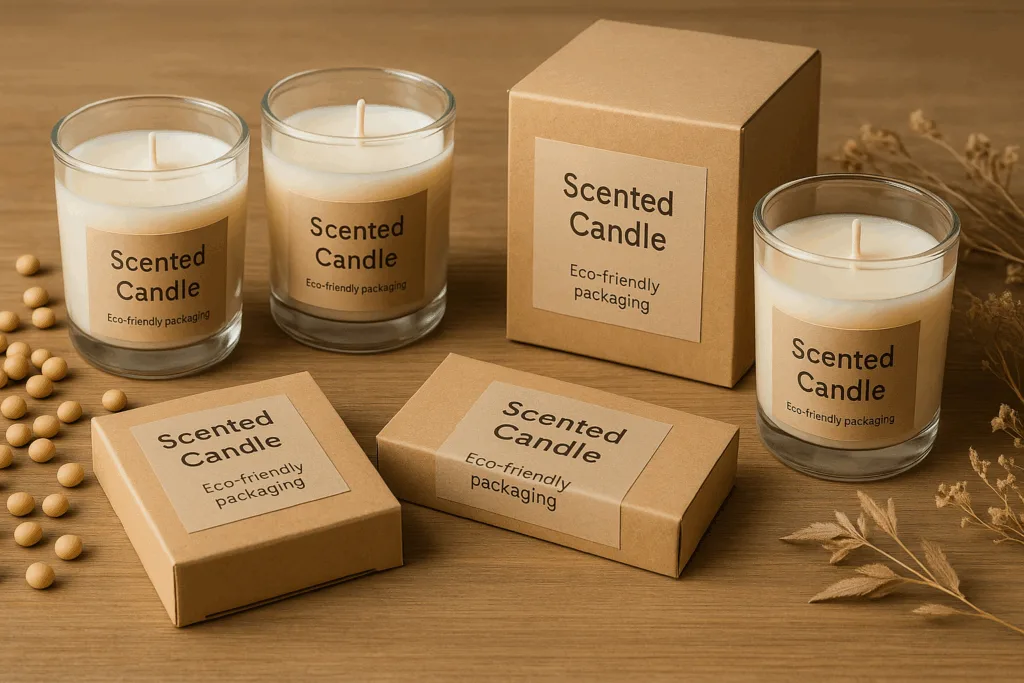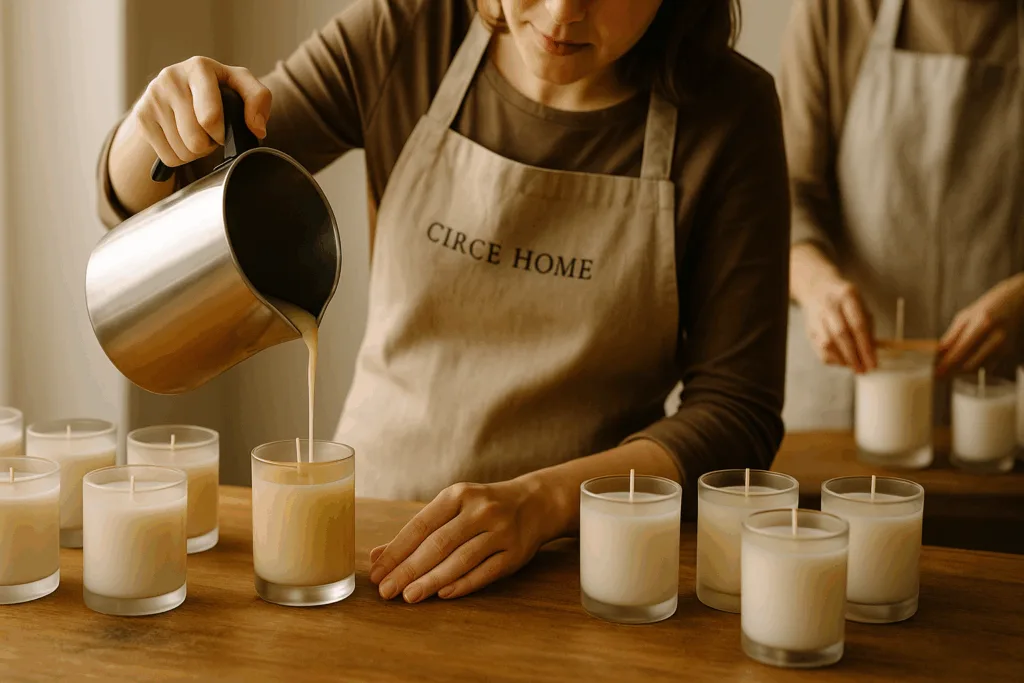Introduction: The Dream of Starting a Candle Business
Starting a candle business begins with a spark—a moment of sensory inspiration. The soft glow of a candle, its fragrance wafting through a quiet room, evokes a sense of comfort and luxury that transcends the ordinary. For many entrepreneurs, this emotional connection is the foundation of their brand vision. Candles represent more than light; they embody atmosphere, ritual, and identity.
But as countless aspiring brands quickly discover, turning that dream into a viable business requires more than creativity. Beneath the surface lies a world of production logistics, cost structures, and manufacturing realities that few first-time founders anticipate. Especially for those dreaming of a small candle business, understanding how factories operate, and what drives cost efficiency, is critical to long-term success.
At Circe Home, we collaborate with private-label brands and wholesalers to transform candle concepts into premium, scalable products. Our philosophy combines artistry and industry—pairing nature-inspired design with manufacturing insight to illuminate the path from idea to global market.
The Truth About a “Small Candle Business”
The term small candle business is often misunderstood. Many new entrepreneurs assume that producing fewer candles means lower costs or easier production. In reality, small-batch orders face the same (or even higher) per-unit costs as large-scale production runs.
Factories operate on principles of scale efficiency. Whether you order 100 or 2000 candle gift sets, the factory still undergoes the same setup: wax melting, fragrance blending, jar preparation, labeling, and packaging. These fixed costs remain constant regardless of quantity, meaning small runs yield significantly higher unit prices.
A small candle business, therefore, should not mean small order quantities; it should represent a focused, brand-led approach with smart investment. Understanding the economics behind candle production is essential for building a foundation that can grow sustainably.
Understanding the Economics Behind Candle Production
Candle production involves numerous fixed and variable costs. Fixed costs include machine setup, labor calibration, and tooling fees for printing or packaging. Variable costs include wax, fragrance, and vessel usage per unit. Here’s a breakdown:
| Cost Type | Example | Effect on MOQ (Minimum Order Quantity) |
|---|---|---|
| Fixed Cost | Printing setup, mold creation, equipment calibration | Same cost whether 100 or 2000 sets |
| Variable Cost | Wax, fragrance, wicks, jars | Increases linearly with quantity |
| Labor | Mixing, pouring, labeling | Flat setup cost + per-unit labor |
| Logistics | Carton packing, shipping | Depends on weight and volume |
When producing 100 gift sets, those fixed costs are spread over fewer units, inflating per-unit pricing. Producing 2000 gift sets spreads the same costs thinner, lowering the price dramatically. This is why a 100-set production run can end up costing nearly the same total amount as 2000 sets.
Why 100 Sets Cost the Same as 2000 Sets
Every production cycle includes preparation that doesn’t scale down proportionally. Wax tanks must be heated, fragrances must be measured and blended, containers prepped, labels aligned, and packaging machinery configured. Whether you’re pouring 100 or 2000 sets, the time and resource investment are nearly identical.
Example Calculation:
| Order Size | Estimated Total Cost | Per Unit Cost |
| 100 sets | $2,000 | $20 per set |
| 2000 sets | $4,000 | $2 per set |
This example highlights a crucial reality: smaller runs can feel deceptively flexible but lead to disproportionately high costs. New brands that “test the waters” with minimal orders often find themselves paying the same total amount as if they had scaled up.
The Hidden Costs of Small-Batch Candle Gift Sets
Small candle businesses face several hidden costs that aren’t apparent at first glance:
- Label and Packaging Setup: Each custom design requires setup fees, even for short runs.
- Fragrance Oil MOQ: Suppliers often require minimum fragrance oil orders that exceed what 100 sets would use.
- Container Sourcing: Factories may impose minimums for jars and lids.
- Quality Control & Testing: Burn tests and scent evaluations consume both materials and time.
- Shipping Inefficiencies: Smaller volumes reduce freight efficiency, increasing per-unit logistics cost.
Circe Home encourages entrepreneurs to understand these structural factors before committing to small runs. Transparent education ensures realistic financial planning and prevents disappointment down the production line.
The Global Candle Supply Chain: China’s Role
China remains the epicenter of candle manufacturing due to its developed infrastructure, skilled workforce, and advanced production technology. However, the notion that China offers “cheap” production is misleading. Prices are competitive because factories are optimized for high-volume output. The efficiency that drives low unit costs depends entirely on scale.
For startups ordering small batches, this means pricing won’t mirror bulk production rates. Yet the benefit lies in world-class quality control, consistency, and scalability once the brand grows. Choosing the right manufacturing partner—one who understands your long-term vision—is key.
Choosing the Right Wax for Scalable Production
The choice of wax influences not only the sensory experience but also the economics of production.
| Wax Type | Advantages | Drawbacks | Ideal Use Case |
| Soy Wax | Clean burn, sustainable, readily available | Soft texture, longer curing | Eco-friendly brands |
| Coconut Wax | Excellent scent throw, smooth surface | High cost | Luxury wellness lines |
| Paraffin | Affordable, vibrant scent diffusion | Not renewable | Budget-friendly collections |
| Beeswax | Natural, beautiful golden tone | Expensive | Premium artisanal collections |
For scalability, soy or soy-coconut blends are optimal. They balance sustainability, scent throw, and affordability for brands planning to expand beyond initial runs.
Fragrance Oils and MOQ Challenges
Fragrance customization is both an opportunity and a challenge. Many suppliers require a minimum order quantity (MOQ) of several kilograms per scent. When producing small quantities, this creates excess inventory and cost waste.
Instead of developing multiple scents early on, new brands should focus on 2–3 signature fragrances across emotional families (floral, woody, and citrus). This focused approach allows for brand recognition while maintaining manageable inventory costs.
Jar and Vessel Sourcing Realities
Candle jars define aesthetic identity but come with practical limitations:
- MOQ: Custom jars typically start at 1000–3000 pieces per color or mold.
- Printing Fees: Silk-screening and decal setup are charged per artwork.
- Lead Time: Custom glass takes weeks to produce and inspect.
To mitigate cost, small brands should start with standard vessels in neutral colors. Circe Home offers modular packaging systems that allow partial customization—a cost-effective solution that retains visual uniqueness.
Wick Standardization and Testing
Each candle formula requires wick testing to ensure even burn and optimal scent throw. Testing consumes materials and extends timelines. New brands often underestimate this phase. Instead of testing multiple vessel and wick combinations, we recommend standardizing on a single candle type for the initial launch. This simplifies testing and guarantees consistency.
How Circe Home Manages Small Private Label Orders
At Circe Home, we design flexible yet transparent programs for small brands. Our goal is not to minimize cost unrealistically but to maximize value through intelligent structure:
- Shared production runs to reduce setup costs.
- Predefined jar and packaging options.
- Streamlined fragrance development.
- Transparent MOQ and pricing breakdowns.
This structure helps startups transition from prototype to scalable production without compromising brand quality.
From Prototype to Production: The Real Timeline
Developing a candle gift set typically follows these steps:
- Concept Design – Scent family and packaging inspiration.
- Sampling & Testing – Wax blend trials, fragrance load tests, wick calibration.
- Artwork & Approval – Label and box design confirmation.
- Production – 25–35 days average lead time.
- Quality Control – Burn testing and scent evaluation.
- Logistics & Delivery – Packaging, export, and shipment.
From concept to delivery, expect 8–10 weeks for completion—a timeline many startups underestimate.
Designing Candle Gift Sets That Sell
Gift sets elevate brand perception and encourage higher average order value. A strong set design unites scent harmony with visual balance. Some effective examples include:
- Seasons of Light: Spring Blossom, Summer Citrus, Autumn Wood, Winter Spice.
- Wellness Rituals: Calm, Focus, Restore, Sleep.
- Elements Collection: Earth, Air, Fire, Water.
Each theme appeals to specific audiences and emotional experiences. The key is creating cohesion and storytelling through scent and packaging.
Top Candle Gift Set Concepts for New Brands
| Concept | Target Audience | Materials |
| Minimalist Glass Trio | Modern homes, eco-focused consumers | Frosted glass, soy wax |
| Botanical Tin Set | Travelers, gift buyers | Recyclable tin, herbal scents |
| Luxury Duo Box | Corporate gifts, premium retail | Magnetic closure box, foil print |
| Seasonal Discovery Set | Retail boutiques | Scent rotation concept |
Circe Home assists in designing such sets, balancing aesthetic value with production feasibility.
Brand Identity Through Packaging
Packaging is storytelling in form. Minimalist layouts, muted color palettes, and tactile finishes communicate refinement. Overly complex designs often inflate cost without improving perception.
Circe Home offers semi-custom packaging templates that can be adapted to your logo and color palette. This reduces setup fees while maintaining an elegant presentation.
Case Study: Small Brand, Big Vision
A European wellness startup approached Circe Home seeking to produce 150 gift sets. After reviewing cost structure, they scaled their order to 1500 sets. This decision reduced their per-unit cost by 70% and allowed them to reinvest savings into marketing.
With consistent quality and strong brand messaging, the company entered boutique retail channels within one season, proving that thoughtful scaling yields real success.
How to Price Candle Gift Sets Correctly
To ensure profitability, use the Rule of Three:
- Production Cost (Base): Wax, fragrance, jar, labor, packaging.
- Overhead (Middle): Branding, marketing, photography.
- Profit Margin (Top): Target 60–70% retail markup.
For example, if each candle costs $5 to produce, wholesale pricing should be around $10 and retail $20. This structure supports sustainability even after discounts or wholesale negotiations.
Balancing Quality and Quantity
Underproducing can hurt your brand reputation as much as overproducing. Limited runs lead to supply shortages and inconsistent quality due to incomplete machine calibration. Producing at viable scale ensures consistency, better margins, and reliable delivery.
Sustainability in Small Candle Business
Even at small scale, sustainability can be a core brand pillar:
- Choose biodegradable waxes (soy, coconut).
- Use recyclable jars and packaging.
- Offer refill systems to build customer loyalty.
- Partner with FSC-certified suppliers for paper goods.
Circe Home prioritizes eco-conscious materials to help clients align with modern ethical values.
Building Supplier Relationships for Growth
Successful partnerships depend on transparency and communication. Share your growth projections with your manufacturer—it builds trust and flexibility. Reliable suppliers often offer better terms and shared sourcing as brands expand.
Circe Home views every small client as a long-term collaborator, not a one-time project. Our growth is intertwined with yours.
Marketing Candle Gift Sets Online
Post-production, marketing determines success. Focus on:
- SEO: Use scent-related keywords like “amber candle gift set” or “soy wax relaxation candles.”
- Photography: Natural lighting, clean composition, and lifestyle context.
- Content Marketing: Tell the story of your brand’s values and craftsmanship.
- Social Media: Collaborate with home décor and wellness influencers.
Every photo and caption should reflect your brand’s sensory experience—calm, warmth, and authenticity.
Wholesale vs. Retail Start Strategies
Wholesale brings stability but smaller margins. Retail (DTC) offers higher profits but slower sales. Many successful small candle businesses adopt a hybrid model—selling online while supplying select boutiques to balance cash flow.
Common Pitfalls for Small Candle Startups
- Believing small batches reduce cost.
- Ignoring MOQ implications for packaging.
- Over-customizing designs too early.
- Lacking a structured pricing strategy.
- Underestimating production timelines.
Avoiding these errors preserves both capital and momentum.
The Emotional Side of Candle Entrepreneurship
Building a candle brand requires patience. Each stage—testing, sampling, refining—is an act of dedication. The journey reflects the very essence of candles: slow, intentional, transformative.
At Circe Home, we believe in honoring that process. Every candle poured carries the artisan’s calm, a reflection of craftsmanship and care.
Conclusion & Call to Action
Starting your candle business is more than launching a product—it’s crafting a sensory experience that connects people with peace and beauty. Understanding production economics and embracing scalable planning ensures your glow lasts beyond the first burn.
Circe Home invites you to begin that journey with us. From scent design to sustainable packaging, our private-label expertise transforms your candle dream into a luminous reality.
🌿 Illuminate your brand with Circe Home—where craftsmanship meets conscious production.
FAQ: How to Start Your Candle Business
How much should I invest to start a candle business?
Budget $3,000–5,000 for an initial production run of 1000–2000 sets, including fragrance, packaging, and testing.
Can I order only 100 candle gift sets?
You can, but expect high per-unit costs. Fixed setup fees mean 100 sets may cost nearly as much as 2000.
What’s the best wax for small candle businesses?
Soy or soy-coconut blends balance sustainability, scent quality, and affordability.
How do I design candle gift sets that sell?
Focus on cohesive storytelling—themes like seasons, emotions, or rituals resonate deeply.
Why is China ideal for candle manufacturing?
China’s infrastructure, technology, and material sourcing enable consistent, scalable, and high-quality production.
How can Circe Home support my small candle brand?
We offer end-to-end private-label candle manufacturing—from fragrance creation to sustainable packaging—tailored for brands ready to scale.

